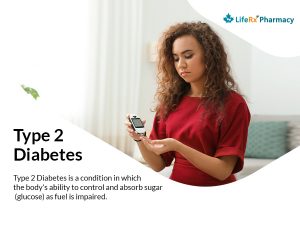Type 2 Diabetes is a condition in which the body’s ability to control and absorb sugar (glucose) as fuel is impaired. Too much sugar circulates in the bloodstream as a result of this long-term (chronic) disease. This type of diabetes is more common in people in their 40s and 50s. It was previously known as adult-onset diabetes.
High blood sugar levels can cause problems with the circulatory, neurological, and immunological systems.
Insulin is a hormone produced by the pancreas that functions as a key to allowing blood sugar into your body’s cells for energy use. Insulin resistance occurs when cells in patients with type 2 diabetes do not respond normally to insulin.
To get cells to respond, your pancreas produces more insulin. When your pancreas can’t compete, your blood sugar levels rise, causing prediabetes and type 2 diabetes to develop.
Prolonged uncontrolled Type 2 diabetes can result in chronically high blood glucose levels, which can cause a variety of symptoms as well as severe complications.
Risk factors:
While some risk factors for type 2 diabetes-like age, family history are beyond our control, some lifestyle choices can potentially increase your chances of acquiring the disease. Some of them are:
- Being Obese: Living with an excessive amount of weight or likely to have extra fatty tissue, can make your cells more insulin resistant.
- Sedentary lifestyle: Adopting a more sedentary way of living. or lack of physical activities makes your cells more resistant to insulin.
- Processed and fatty food Choice: Consumption of a high-fat, high-processed, or packed food contains a high amount of sugar and refined carbs which are also not good for insulin secretion.
Signs & Symptoms:
Some common signs and symptoms of diabetes Type-2 are :
- Increased thirst
- Frequent urination
- Bed-wetting in children who previously didn’t wet the bed during the night
- Extreme hunger
- Unintended weight loss
- Irritability and other mood changes
- Fatigue and weakness
- Blurred vision

If you are suffering from diabetes type-2 body can’t effectively use insulin to bring glucose into your cells. As a result, your tissues, muscles, and organs depend on external energy sources. Complications that occur if your blood glucose levels have been high for a long time are:
- Difficulties with the eyes (Diabetic Retinopathy)
- Neuropathy which characterized by numbness in the extremities.
- Renal failure (Nephropathy)
- Periodontitis (Gum Disease)
- Stroke or Heart attack
Diagnostic tests like the Hemoglobin A1C test, fasting plasma glucose test, Oral glucose tolerance test helps your doctor how severe your diabetes is.
Diabetes Management:
Management of type-2 diabetes is collaborative teamwork. One needs to work on their lifestyle healthy changes which can bring a big impact on the improvement of blood sugar.
While type 2 diabetes cannot always be prevented, there are a few lifestyle changes that can help delay or even prevent its onset. Even if you have higher risk factors, such as prediabetes, they are quite beneficial
- Diet: A diet rich in fruits, vegetables, good carbs, healthy fats, and very little refined sugar is the greatest way to prevent type 2 diabetes.
- Exercise: Adults should exercise for 150 minutes per week, which translates to 30 minutes per day, five days a week, to keep them healthy and fit.
- Controlling your weight: Maintaining a healthy weight helps you avoid chronic diseases which are associated with diabetes.
FAQ:
What is type 2 diabetes?
Type 2 diabetes develops when the pancreas makes less insulin than the body needs, and the body cells stop responding to insulin. They don’t take in sugar as they should. Sugar builds up in your blood.
When to take insulin for type 2 diabetes?
A person with type 2 diabetes if having their A1C above 9% along with the symptoms is mostly recommended to use insulin based on their body conditions.
What is the difference between Type 1 and Type 2 diabetes?
Type 1 diabetes is a genetic disorder that often shows up early in life, and type 2 is largely diet-related and develops over time. If you have type 1 diabetes, your immune system is attacking and destroying the insulin-producing cells in your pancreas. Whereas, in Type 2 your body s not respond to insulin secreted via the pancreas.
How to reverse type 2 diabetes?
There’s no cure for type 2 diabetes, studies show it’s possible to reverse it. Through diet changes and weight loss, one may be able to reach and hold normal blood sugar levels without medication.
How to treat type 2 diabetes?
Type 2 diabetes has no cure but reducing weight, living a healthy lifestyle, and exercising can help you manage it. If diet and exercise aren’t adequate to control your blood sugar, diabetes medications or insulin therapy may be used to treat diabetes.
What to eat with type 2 diabetes?
One should avoid processed, refined and packed food to reduce the intake of sugar and food n high carbohydrates. One can eat green leafy vegetables, fruits, whole grains, legumes, nuts to live a healthy life.
References


